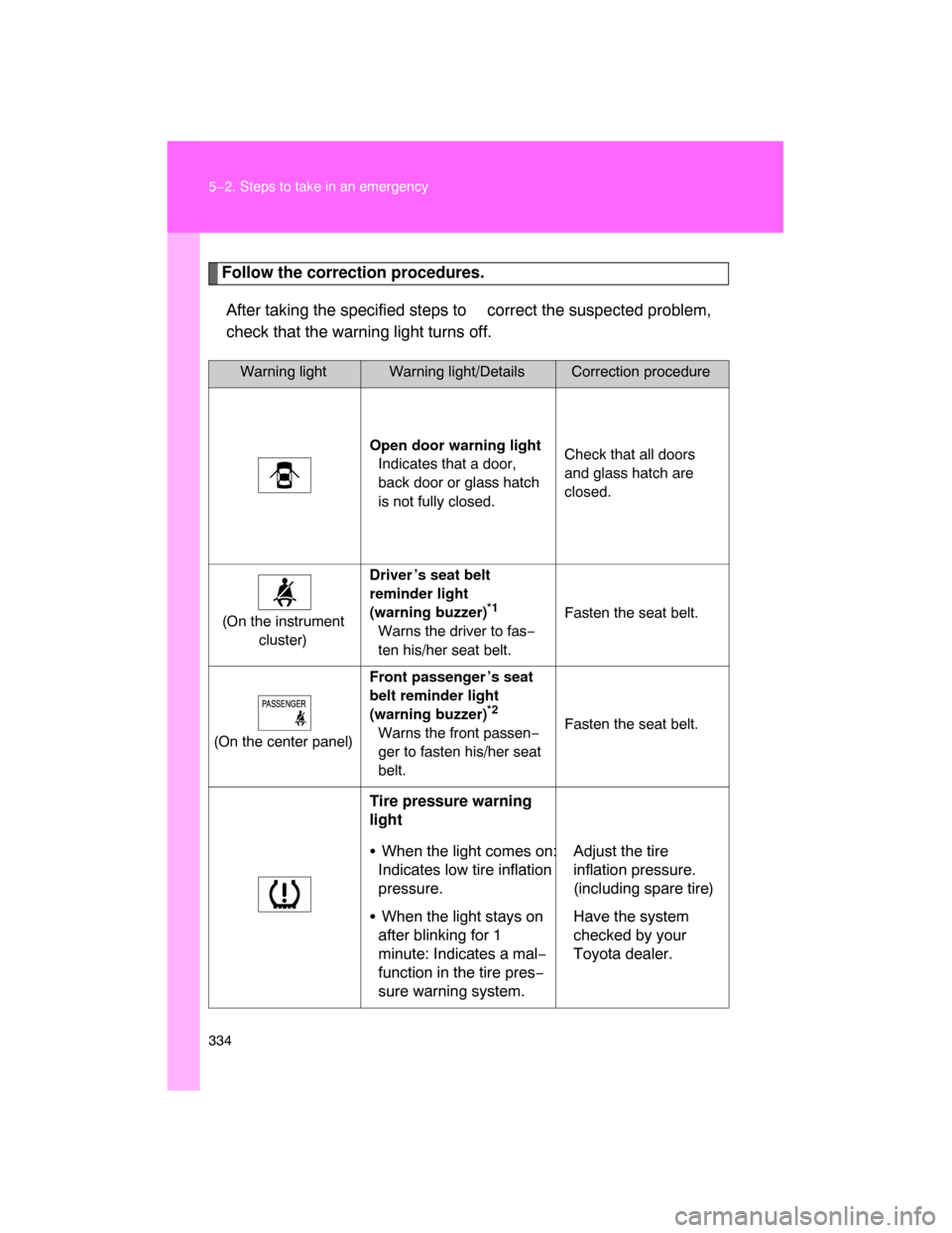Page 292 of 400

296
4−3. Do−it−yourself maintenance
Wheels
�When replacing wheels
The wheels of your Toyota are equipped with sensors that allow the tire
pressure warning system sensors to provide advanced warning in the
event of a loss in tire inflation pressure. Whenever wheels are replaced,
the tire pressure warning valve and transmitter must be switched over
from the old wheels. (
P. 288) If a wheel is bent, cracked or heavily corroded, it should be
replaced.
Otherwise, the tire may separate from the wheel or cause loss of
handling control.
� Wheel selection
When replacing wheels, care should be taken to ensure that
they are equivalent to those removed in load capacity, diameter,
rim width, and offset.
Replacement wheels are available at your Toyota dealer.
Toyota does not recommend using:
�
Wheels of different sizes or types
�Used wheels
�
Bent wheels that have been straightened
�
Aluminum wheel precautions (if equipped)
�Use only Toyota wheel nuts and wrench designed for use with
your aluminum wheels.
� When rotating, repairing or changing your tires, check that the
wheel nuts are still tight after driving 1000 miles (1600 km).
�
Be careful not to damage the aluminum wheels when using
tire chains.
� Use only Toyota genuine balance weights or equivalent and a
plastic or rubber hammer when balancing your wheels.
Page 293 of 400
297
4−3. Do−it−yourself maintenance
4
Maintenance and care
CAUTION
�When replacing wheels
�Do not use wheels that are a different size from those recommended in
the Owner ’s Manual, as this may result in loss of handling control.
�Never use an inner tube in a leaking wheel which is designed for a
tubeless tire. Doing so may result in an accident, causing death or seri−
ous injury.
NOTICE
�Replacing tire pressure warning valves and transmitters
�Because tire repair or replacement may affect the tire pressure warn−
ing valves and transmitters, make su re to have tires serviced by your
Toyota dealer or other qualified service shop. In addition, make sure to
purchase your tire pressure warning valves and transmitters at your
Toyota dealer.
�Ensure that only Genuine Toyota wheels are used on your vehicle.
Tire pressure warning valves and transmitters may not work properly
with non−genuine wheels.
Page 326 of 400
5
When trouble arises
331
5−2. Steps to take in an emergency
If a war ning light tur ns on or a war ning buzzer sounds...
Stop the vehicle immediately. Continuing to drive the vehicle may be dangerous.
The following warning indicates a possible problem in the brake sys−
tem. Immediately stop the vehicle
in a safe place and contact your
Toyota dealer.
Warning lightWarning light/Details
Brake system warning light
�Low brake fluid
�Malfunction in the brake system
This light also comes on when the parking brake is
not released. If the light turns off after the parking
brake is fully released, the system is operating nor−
mally.
Calmly perform the following actions if any of the warning lights turn
on or flash. If a light turns on or flashes, but then turns off, this does
not necessarily indicate a malfunction in the system.
Page 327 of 400

332 5−2. Steps to take in an emergency
Stop the vehicle immediately.
The following warnings indicate the possibility of damage to the vehi−
cle that may lead to an accident. Immediately stop the vehicle in a
safe place and contact your Toyota dealer.
*: The light may come on when the oil level is extremely low. It is not designed
to indicate low oil level, and the oil level must be checked using the engine
oil level dipstick.
Have the vehicle inspected immediately.
Failing to investigate the cause of the following warnings may lead to
the system operating abnormally
and possibly cause an accident.
Have the vehicle inspected by your Toyota dealer immediately.
Warning lightWarning light/Details
Charging system warning light
Indicates a malfunction in the vehicle’s charging sys−
tem.
Low engine oil pressure warning light
Indicates that the engine oil pressure is too low*.
Warning lightWarning light/Details
Malfunction indicator lamp
Indicates a malfunction in:
�The electronic engine control system;
�The electronic throttle control system;
�The electronic automatic transmission control sys−
tem; or
�Emission control system.
SRS warning light
Indicates a malfunction in:
�The SRS airbag system;
�The front passenger occupant classification system;
or
�The seat belt pretensioner system.
Page 328 of 400
5
When trouble arises
333 5−2. Steps to take in an emergency
(U.S.A.)
(Canada)ABS warning light
Indicates a malfunction in:
�The ABS; or
�The brake assist system.
VSC/TRAC warning light
Indicates a malfunction in:
�The vehicle stability control system;
�The traction control system;
�The active traction control system (if equipped); or
�The AUTO LSD system (2WD models).
(Automatic transmis−
sion vehicles)Automatic transmission fluid temperature warn�
ing light
Indicates that the automatic transmission fluid tem−
perature is too high.
(if equipped)Unengaged “Park” warning light
Malfunction in the transmission “Park” mechanism.
Warning lightWarning light/Details
Page 329 of 400

334 5−2. Steps to take in an emergency
Follow the correction procedures.
After taking the specified steps to correct the suspected problem,
check that the warning light turns off.
Warning lightWarning light/Details Correction procedure
Open door warning light
Indicates that a door,
back door or glass hatch
is not fully closed.Check that all doors
and glass hatch are
closed.
(On the instrument
cluster)Driver ’s seat belt
reminder light
(warning buzzer)
*1
Warns the driver to fas−
ten his/her seat belt.Fasten the seat belt.
(On the center panel)Front passenger ’s seat
belt reminder light
(warning buzzer)
*2
Warns the front passen−
ger to fasten his/her seat
belt.Fasten the seat belt.
Tire pressure warning
light
�When the light comes on:
Indicates low tire inflation
pressure.Adjust the tire
inflation pressure.
(including spare tire)
�When the light stays on
after blinking for 1
minute: Indicates a mal−
function in the tire pres−
sure warning system.
Have the system
checked by your
Toyota dealer.
Page 330 of 400

5
When trouble arises
335 5−2. Steps to take in an emergency
*1: Driver’s seat belt reminder:
The driver ’s seat belt reminder sounds to alert the driver that his or her seat
belt is not fastened. Once the engine switch is turned to the ON or START
position, the buzzer sounds for 6 seconds. If the vehicle has reached a
speed of at least 12 mph (20 km/h), the buzzer sounds intermittently for 10
seconds. Then, if the seat belt is still unfastened, the buzzer will sound in a
different tone for 20 more seconds.
*2: Front passenger ’s seat belt reminder:
The front passenger ’s seat belt reminder sounds to alert the front passenger
that his or her seat belt is not fastened. The buzzer sounds intermittently for
10 seconds after the vehicle has reached a speed of at least 12 mph (20 km/
h). Then, if the seat belt is still unfastened, the buzzer will sound in a different
tone for 20 more seconds.Low fuel level warning
light
Low level of fuel.Refuel the vehicle.
(U.S.A.)Engine oil replacement
reminder light
�Illuminates for about 3
seconds and then flashes
for about 12 seconds: Indi−
cates that the engine oil is
scheduled to be changed.Check the engine oil,
and change if neces−
sary.
�Comes on and remains:
Indicates that the engine
oil should be changed.
Check and change the
engine oil.
Warning lightWarning light/DetailsCorrection procedure
Page 331 of 400

336 5−2. Steps to take in an emergency
� Key reminder buzzer
The buzzer indicates that the key has not been removed (with the engine
switch in the ACC or LOCK position and the driver ’s door opened).
� If the malfunction indicator lamp comes on while driving
First check the following:
�Is your vehicle low on gas?
If it is, refuel the vehicle immediately.
� Is the fuel tank cap loose?
If it is, tighten it securely.
The light will go off after taking several driving trips.
If the light does not go off even after several trips, contact your Toyota dealer
as soon as possible.
� Front passenger detection sensor and passenger seat belt reminder
If luggage or other load is placed on the front passenger seat, depending on
its weight, the reminder light to flash and buzzer to sound.
�
When the tire pressure warning light comes on
Check the tire inflation pressure and adjust to the appropriate level.
�The tire pressure warning light may turn on due to natural causes
The tire pressure warning light may turn on due to natural causes such
as natural air leaks or tire inflation pressure changes caused by temper−
ature. In this case, adjusting the ti
re inflation pressu re will turn off the
warning light after a few minutes.
�When a tire is replaced with a spare tire
The spare tire is also equipped with the tire pressure warning valve and
transmitter. The tire pressu
re warning light will turn on if the tire inflation
pressure of the spare tire is low. If a tire goes flat, even though the flat
tire is replaced with the spare tire, the warning light does not turn off.
Replace the spare tire with the repair
ed tire and adjust the proper tire
inflation pressure. The ti re pressure warn ing light will turn off after a few
minutes.